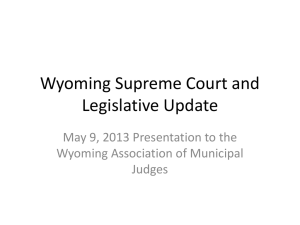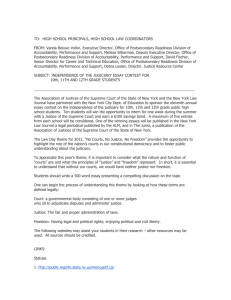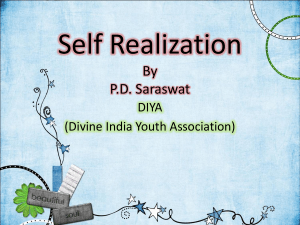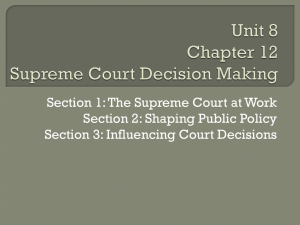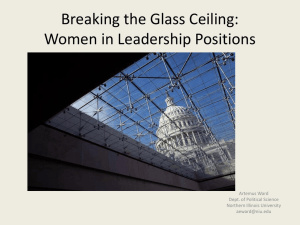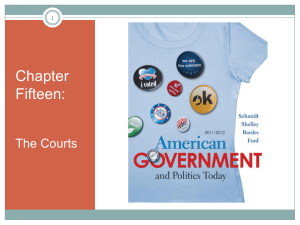socio – economic rights and the supreme court - ESCR-Net
advertisement
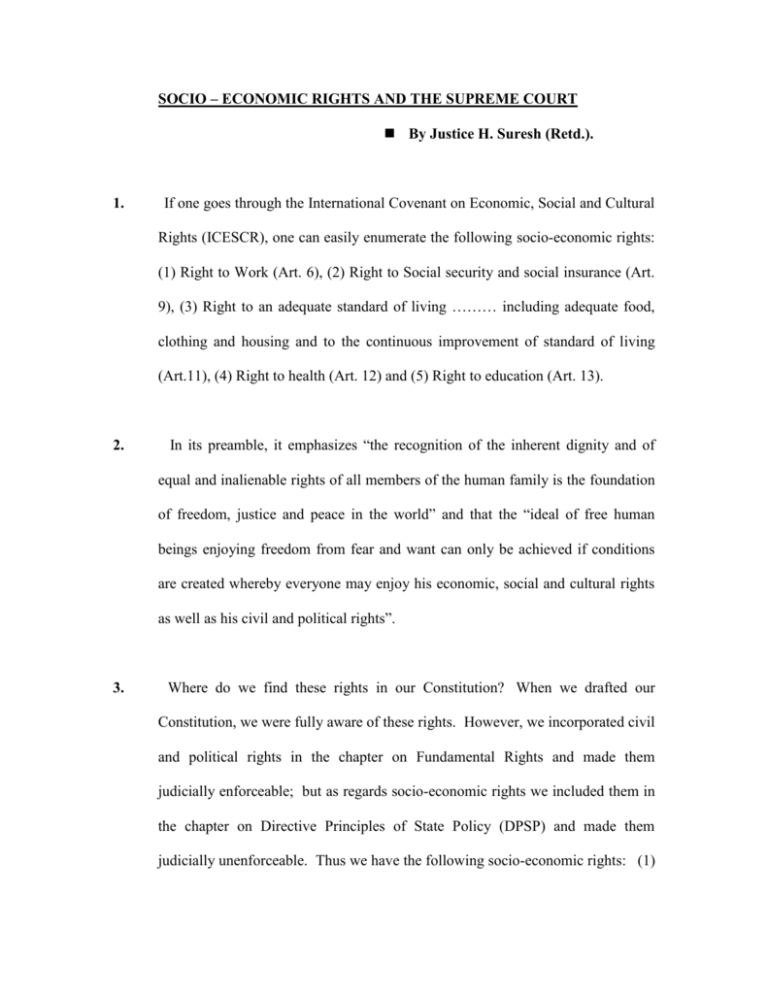
SOCIO – ECONOMIC RIGHTS AND THE SUPREME COURT By Justice H. Suresh (Retd.). 1. If one goes through the International Covenant on Economic, Social and Cultural Rights (ICESCR), one can easily enumerate the following socio-economic rights: (1) Right to Work (Art. 6), (2) Right to Social security and social insurance (Art. 9), (3) Right to an adequate standard of living ……… including adequate food, clothing and housing and to the continuous improvement of standard of living (Art.11), (4) Right to health (Art. 12) and (5) Right to education (Art. 13). 2. In its preamble, it emphasizes “the recognition of the inherent dignity and of equal and inalienable rights of all members of the human family is the foundation of freedom, justice and peace in the world” and that the “ideal of free human beings enjoying freedom from fear and want can only be achieved if conditions are created whereby everyone may enjoy his economic, social and cultural rights as well as his civil and political rights”. 3. Where do we find these rights in our Constitution? When we drafted our Constitution, we were fully aware of these rights. However, we incorporated civil and political rights in the chapter on Fundamental Rights and made them judicially enforceable; but as regards socio-economic rights we included them in the chapter on Directive Principles of State Policy (DPSP) and made them judicially unenforceable. Thus we have the following socio-economic rights: (1) Right to adequate means of Livelihood (Art. 38(a), (2) Right to the health and strength of workers (Art. 39(c), (3) Right to work, to education and public assistance in cases of unemployment, old age, sickness, disablement and undeserved want (Art.41), (4) Right to living wage for workers (Art. 43), (5) Right to decent standard of life and to raise the level of nutrition and to public health (Art. 43 & 44), (6) Right to education (Art. 45 & 46) and (7) Right to environment (Art. 48A). 4. Under the International Human Rights Law, every State has three obligations – the obligation to respect, the obligation to protect and the obligation to fulfil human rights. The obligation to respect requires the State to abstain from doing that which violates, even directly or indirectly, the concerned human right. The obligation to protect requires the State and its agents to take the measures necessary to prevent other individuals or groups from violating or infringing the enjoyment of the right. The obligation to fulfil requires the State to take measures to ensure each person within its jurisdiction has the opportunities to obtain satisfaction of those needs recognized in the human rights instruments which cannot be achieved by personal efforts. All human rights are interdependent, indivisible and inalienable. You take away one, you take away the others. Deny food, deny livelihood, deny shelter and you deny liberty, freedom, and ultimately the right to life and all that goes with life. 5. Realizing the importance of human rights, both ICESCR and DPSP have provided their own mechanism to achieve full implementation of all human rights. Art. 2 of ICESCR says:- “1. Each State Party to the present Covenant undertakes to take steps, individually and through international assistance and cooperation, especially economic and technical, to the maximum of its available resources, with a view to achieving progressively the full realization of the rights recognized in the present Covenant by all appropriate means, including particularly the adoption of legislative measures.” The key words are “to take steps”, “individually and through international cooperation” “to the maximum of its available resources”, “Achieving full realization of the rights” and “by all appropriate adoption of legislative measures”. While all the respect, protect, and fulfil all human obligations are to be the State is progressively the means … (including the States Parties have an obligation to rights, the method and the manner in which discharged have been set out in the above Article. Whenever called upon to explain how it has dealt with these social and economic rights, it has an obligation to demonstrate what “steps” it has taken, and in what manner, and with what “resources” and with what “means”. It has to that it has made use of all its available resources including and that it has adopted all appropriate means to This covenant is of great importance, show international assistance fulfil these rights to its people. particularly in the context of large parts of the world where people are denied the basic needs – such as food, shelter, health protection and education. 6. Under the DPSP, as Art. 37 itself says that these Principles are “fundamental in the governance of the country……….” The Government has an obligation to implement these principles. And the language used as against each of these obligations, it is almost the same as under Art. 2(1) ICESCR. “Art. 38(1): The State shall strive to promote the welfare of the people by securing and protecting as effectively as it may, a social order in which justice, social, economic and political, shall inform all institutions of the national life”. The words as against each obligation, such as “strive to promote” (Art. 38) “direct its policy towards securing” (Art. 39) …. “endeavour to secure…….” (Art. 43)…. “take steps …..” (Art. 43A) “….. promote the educational and economic interests ….. (Art. 46)” “….. endeavour to raise the level of nutrition…… (Art. 47), all indicate a continuous process of “progressive” implementation of these principles. Therefore, the State cannot adopt any “regressive” measure which will hinder the objective of full realization of these rights. 7. For about three decades the Supreme Court was not willing to consider that DPSP were enforceable. The Court was not willing to read the Fundamental Rights and the DPSP together. However, the change come, when the Court found a new meaning of the word “life” in Art. 21: “No person shall be deprived of his life or personal liberty except according to procedure established by law “what is the meaning of the word “life”? Is it any limb or arm of any “body”?, Is it merely “animal existence”? or Is it something mere than these”? In Francis Coralie v/s. Union Territory of Delhi (AIR 1981 SC 746), Bhagwati J. posed the question: “…. Whether the right to life is limited only to protection of limb or faculty, or does it go further and embrace something more,” and answered: “We think that the right to life includes the right to live with human dignity and all that goes along with it, namely, the bare necessaries of life such as adequate nutrition, clothing and shelter over the head and facilities for reading, writing and expressing oneself in diverse forms, freely moving about and mixing and comingling with fellow human beings.” This has been repeated in several other cases. In Shantistar Builders v/s. Narayan Khimalal Totame (AIR 1990 SC 630), the Supreme Court said: “Basic needs of man have traditionally been accepted to be three – food, clothing, and shelter. The right to life is guaranteed in any civilized society. That would take within its sweep the right to food, the right to clothing, the right to decent environment and a reasonable accommodation to live in.” In the case of bonded labourers – Bandhwa Mukti Morcha Case (AIR 1984 SC 802), the Court said: “It is the fundamental right of every one in this country…… to live with human dignity, free from exploitation. This right to live with human dignity enshrined in Art. 21, derives its life-breath from the Directive Principles of State Policy and particularly Clauses (e) and (f) of Art. 39 and Arts. 41 and 42, and at least, therefore, it must include protection of the health and strength of the workers, men and women, and of the tender age of children against abuse, opportunities and facilities for children to develop in a healthy manner and in conditions of freedom and dignity……” In Mohini Jain’s Case (1992)3 SCC 666, Kuldip Singh J. said “Right to life is the compendious expression for all these rights which the courts must enforce because they are basic to the dignified enjoyment of life. It extends to the full range of conduct which the individual is free to pursue.” Article 21 now applies to various facets of life and living. 8. It is here the Supreme Court read into our Constitution several provisions of International Covenants. The Judges also considered DPSP and how the same could be read together with the Fundamental Rights. As stated in the case of Unnikrishnan v/s. State of AP [(1993)1 SCC 645, para 165] “In order to treat a right as fundamental right, it is not necessary that it should be expressly stated as one in Part III of the Constitution. The provisions of Part III and Part IV are supplementary and complementary to each other.” That is why very often the court reads the two together. There is no conflict between the two. It is wrong to assume that fulfillment of obligations relating to social and economic human rights would impair fundamental rights. That is why we incorporated Article 31C (25th Amendment Act 1971) which says, “Notwithstanding anything contained in Article 13, no law giving effect to the policy of the State towards securing all or any of the principles laid down in Part IV shall be deemed to be void on the ground that it is inconsistent with, or takes away or abridges any of the rights conferred by Article 14 or Article 19…..” As Glanville Austin says: “The core of the commitment to the social revolution lies in Part III and IV in the Fundamental Rights and in the Directive Principles of State Policy. These are the conscience of the Constitution.” This is what Bhagwati J. said in Minerva Mills case (AIR 1980 SC 1789 at 1846): “The core of the commitment of the social revolution lies… in the Fundamental Rights and directive principles of state policy.” 9. In Olga Tellis case (AIR 1986 SC 180) the Supreme Court recognized the right to livelihood, and observed “An…. Important facet of that right is the right to livelihood because, no person can live without the means of living, that is, the means of livelihood. If the right to livelihood is not treated as a part of the constitutional right to life, the easiest way of depriving a person of his right to life would be to deprive him of his means of livelihood to the point of abrogation. Such deprivation would not only denude the life of its effective and meaningfulness, but it would make life impossible to life. And yet, such deprivation would not have to be in accordance with the procedure established by law, if the right to livelihood is not regarded as a part of the right to life. That which alone makes it possible to live, leave aside what makes life livable, must be deemed to be an integral component of the right to life.” 10. In Shantistar Builders (AIR 1990 SC 630) right to shelter was recognized. In Chameli Singh v/s. State of U. P. & Anr. [(1996) 2 SCC Pg. 549] it was elaborated; “…. Shelter for a human being, therefore, it not a mere protection of his life and limb. It is his home where he has opportunities to grow physically, mentally, intellectually and spiritually. Right to shelter, therefore, includes adequate living space, safe and decent structure, clean and decent surroundings, sufficient light, pure air and water, electricity, sanitation, and other civic amenities life roads, etc. so as to have easy access to his daily avocation. The right to shelter, therefore, does not mean a mere right to roof over one’s head, but to the entire infrastructure necessary to enable them to live and develop as a human being. Right to shelter when used as an essential requisite to the right to live should be deemed to have been guaranteed as a fundamental right…. The ultimate object of making a man equipped with right to dignity of person and equality of status to enable him to develop himself into a cultured being. Want of decent residence, therefore, frustrates the very object of the constitutional animation of right to equality, economic justice, fundamental right to residence, dignity of person and right to live itself.” 11. In Mohini Jain’s case [(1992) 3 SCC 666] and in Unnikrishnan v/s. State of AP [(1993)1 SCC 645] right to education was held to be a fundamental right. In Delhi Transport Corpn. Case (AIR 1991 SC 101) right to work was recognized as a fundamental right. In West Bengal Farm Labourer’s Association v/s. The Govt. of West Bengal [(1996)4 SCC 37] right to health was recognized as a fundamental right. And we have had large number of cases on right to environment. 12. This was the golden period of the Supreme Court – from about the Last quarter of the 70s till about the middle of 90s. It was during this period the concept of Public Interest Litigation (PIL), or as Bhagwati J. called it – Social Action Litigation came to be developed, mainly for the benefit of large number of poor, marginalized and socially economically weaker sections of the society, and in cases where they have suffered worst form of violation of human rights. Today PIL is totally a different instrument – in very many cases anti people – anti human rights. I mean, anti – socio-economic rights. Today, in every High Court thee is a special Bench reserved for PIL and in the Supreme Court, PILs are entertained whether they fall within Art. 32 or not. However, it is regrettable to know that there is not a single PIL for and on behalf of the poor, the Dalits, the marginalized in any of the Courts, excepting perhaps the one pending in the Supreme Court filed by PUCL on the right to food. Most of the cases are on governance abuse of power, and some even on political controversies. Recently, some of the worst violations of human rights have taken place by virtue of the orders passed by the Courts. 13. In Mumbai, large number of housing settlement around the Sanjay Gandhi National Park were demolished by the Orders of the High Court. Over four lakh people lost their homes, and the Supreme Court would not interfere. Recently, on the question of cut-off date of 1995, when slums are being openly demolished, the Courts are still dithering without without any succor to the poor slum dwellers. In the case of Almitra H. Patel [(2000)8 SCC 19] the Supreme Court observed that giving land to slum dwellers was like giving “premium” to pick-pockets. In the case of Narmada Sardar Sarovar Dam, large number of internally displaced persons could get no relief, all because the Court found the policy of the Government in construction of the Dam was sufficient enough to safeguard the interests of all the persons affected by the project. The Court rejected the plea that the fundamental rights of the tribal, when they lost their homes, and their right to livelihood, are violated. The same approach was adopted in the case of BALCO [(2000) 2 SCC 333]. 14. Again in the case of education, after the T. M. A. Pai Foundation Case, [(2002)8 SCC 481] higher education, particularly professional education became the monopoly of the rich. The Supreme Court did not even bother to consider the impact of their judgments on the question of right of access to higher education as a human right. 15. The question is why this volte-face in the approach of the Supreme Court and other Courts? Why have cases against violation of Socio-economic rights disminished? How could the Courts ignore when all these human rights were read into Art. 21 as part of right to life? Today, the vast poor have no guarantee of any judicial compassion. As observed by Justice V. R. Krishna Iyer (The Hindu dt. 17th December, 2002), in reference, to T. M. A. Pai Foundation Case: “There is no gainsaying the fact that social justice and equal opportunity for educational excellence at all levels have gone by default. Of course, globalization, liberalization, privatization and marketisation have captured the Court’s notice and the Preamble to the Constitution is de facto judicially jettisoned.” These observations aptly apply to all cases of violations of human rights. 16. Sometimes it is said that socio-economic rights are imperfect – or inchoate rights and they cannot be enforced through Courts. It is also stated that civil and political rights can be enforced through Courts by orders of injunction whereas socio-economic rights are positive in their content, and the enforcement of these rights require constant supervision and administrative directions to supervise their implementation. It is also contended that the implementation of these rights involve decisions relating to policy of the Government, and also budgetary considerations. And, now the composition of the Courts is such that with most of the judges coming from a class of affluent and elite lawyers, the judges themselves are reluctant to consider these rights as judicially enforceable. They think that the Courts cannot provide a remedy for every injustice, more so, in the matter of socio-economic rights. 17. However, certain basic principles cannot be ignored. It is too late in the day to categorize these rights as distinct from other civil and political rights. All human rights are universal, indivisible and interdependent. Take away one, and you take away the others. Conversely freedom of one will have no meaning, if you are denied the other rights. For example, freedom of expression will have no meaning, if you are denied your right to shelter or food. In fact, denial of enforcement of socio-economic rights, will eventually weaken civil and political rights. The UDHR itself contemplated an integrated, inter-related scheme of rights. Art. 28 of UDHR says; “Everyone is entitled to a social and international order in which the rights and freedoms set forth in his Declaration can be fully realized.” 18. Our Supreme Court had understood the importance of these rights when it began reading Fundamental Rights and DPSP together. The experience of judicial intervention, in the matter of recognizing and enforcing Socio-economic rights shows that it had its own impact inasmuch as the Government had to think twice before acting in derogation of these rights. It is true, the Supreme Court granted mostly declaratory reliefs and on the basis of declared guidelines, the execution and enforcement of the orders were all left to the executive. Of course, the Court had, also evolved certain innovative tools, by way of constant monitoring so as to ensure that these rights are fulfilled. It is only now, when the Court is tended to abandon its holistic approach in the matter of human rights, the Governments have become emboldened to violate socio-economic rights with impunity. Imagine, the Chief Minister of a State openly saying that he would have all the slums and homes which have come into existence, after a certain cut-off date, demolished without even bothering about lakhs of people being rendered homeless! He forgets that his action would not only infringe Art. 21 – right to life, as interpreted by the Supreme Court, but also would violate he States obligations as envisaged under the UDHR and also ICESCR. And we have seen that slums are being demolished all over the country, and the Courts are doing nothing! 19. It is often said that the structures in a slum, are all illegal and are built without legal permission. But, how many of us understand that their forcible demolition so as to render people homeless is unconstitutional? When forced evictions take place, it does not mean destruction of houses in a slum area. It means removal of individuals, families or communities from their homes, from their land or neighbourhood. It also means destroying the livelihood, culture, community, and also their possessions and belongings, besides the suffering, the trauma and the feeling of insecurity. 20. Whenever the right to housing is violated by forced evictions, a other rights are also affected. The rights to freedom of one’s residence, recognized in many are infringed when forced widely established, with movement and to choose international laws and national constitutions, evictions occur. The right to security of the person, means little in practical terms when people are forcibly evicted violence, bulldozers and intimidation. Arrests or killings of community leaders opposing forced evictions are common and violate the right to life, expression and the freedom to join organizations of one’s 21. number of freedom of choice. In all forced evictions, women and children are the worst sufferers. Children lose their right to education. Men and women lose their source employment, and their right to work is breached. When they are their right to health is affected. When families and eviction, the right to family life is infringed. of thrown on the street, communities are torn apart by When the eviction squads enter one’s home, the right to privacy which is a part of the right to life, and the right to security of the home are violated. 22. Thus the situation leads to a series of violation of human rights of all kind. The Government has a constitutional obligation to see that people are all properly rehabilitated, before any eviction takes place. In fact, the South African Courts have gone far ahead of all other Courts in the world. They have repeatedly said that the State has a constitutional obligation to provide for access to adequate housing, and people in desperate circumstances, or people in crisis, cannot be evicted unless the Government “finds a place where they could lawfully live”. [See Baartman & Ors. v/s. Port of Elizabeth Municipality] (Supreme Court of Appeal Case 446/2002). The well known case is the case of Grootboom decided by the Constitutional Court: Govt. of the Republic of South Africa vs/. Grootboom (2000) 11 BCLR 1169 (CC). 23. So also in the case of Right to Food, it is not clear what is the approach of the Supreme Court, in the only case pending i. e. the PUCL case (Writ Petition No.196 of 2001). The Supreme Court has passed series of orders. Broadly the approach of the Court appears to be to identify “the aged, infirm, disabled, destitute women, destitute men who are in danger of starvation, pregnant and lactating women and destitute children …..” And then to distribute food-grains through various schemes, such as Targeted Public Distribution Scheme (TDPS) for BPL families, Antyodaya Anna Yojana, Mid-day Meal Scheme, Annapurna Scheme, and to give assistance through National Old-age Pension Scheme, Integrated Child Development Scheme, National Maternity Benefit Scheme, etc. The Supreme Court is constantly monitoring the implementation of these schemes. Undoubtedly this is a humanist approach. But what is required is a shift from the domain of benevolence to that of a right. Right to food is not charity. It should be an enforceable Right “as an art of adequate standard of living.” It is something more than food for survival. It is considered as a component of “adequate standard of living” (See Articles 11(1) & (2) of ICESCR). It must necessarily mean nutritious food for the purpose of maintaining adequate standard of living. It also involves fulfillment of various other rights. Article 11(2) of ICESCR itself mentions certain measures such as (1) to improve methods of production, conservation and distribution, (2) making use of technical and scientific knowledge, (3) reforming agrarian systems, (4) regulating food-importing and exporting and above all, (5) access to food adequate in terms of nutritional quality and quantity. 24. Though we have been saying that the “Right to Food” case is an experiment on the question of justifiability of the Right, it is highly doubtful whether the Court will formulate what precisely is that right? What are the main threats to fulfillment of the right? Will the Court be able to formulate the frame work of rights for policy and action? These questions have arisen in the case of all socio-economic rights, despite the judges in the past showing an innovative path. Our judges still think that judicial enforcement of these rights is not feasible, and some think that it is inappropriate. They are not prepared to consider that a denial of right to shelter, health or livelihood is as much a violation of human rights as an infringement of fundamental freedom under Art. 19. For them, the socio-economic rights are still “outside the law” and since, generally there is no question of “adjudication”, (as traditionally that is the role of the Court), they think, that these rights are beyond their “concern”. 25. However, the question is how do we enforce the socio-economic rights? If the Courts are not the proper institutions, should we leave it to the political and administrative organs of he State? If right to shelter is left to the political and administrative will of the State, and if slums are allowed to be demolished, every day, what will be left of that right? And if at any stage the rights are abrogated for some, and sustained for the others, would not the Court be required to intervene, at least on the ground of discrimination? In other words, is it not possible to eliminate judicial role or supervision to ensure hat the State lives upto its affirmative obligations as contained in ICESCR? Whenever there is any breach of any right – Civil, political, social, economic or cultural – there has to be a remedy. The judiciary is still the best guarantee for a just remedy. 26. The only other institutions, one can think of, are the National Human Rights Commission (NHRC) or the State Human Rights Commission (SHRC). The Protection of Human Rights Act, 1993, under which these Commissions are constituted, says in is preamble that the Law is being enacted, for the purpose of “better protection of human rights and for matters connected therewith”. Note the words: “better protection” – better than all other institutions. Human Rights are defined as (u/s. 1(d): “The rights relating to life, liberty, equality and dignity of the individual guaranteed by the Constitution or embodied in the international Covenants and enforceable by Courts in India.” S.1(f): “International Covenants” means the International Civil and Political Rights and the International Covenant on Cultural Rights adopted by the General Assembly Covenant on Economic, Social and of the United Nations on the 16 th December, 1966.” Thus all these human rights “relating to life, liberty, equality and dignity of the individual” are all statutorily recognized. Can there still be any dichotomy as between any of these rights? 27. Though the definition of human rights, includes ESCR, I am yet to see ether NHRC or SHRCS taking any initiative either to protect ESCR or to prevent violations of these Rights. When, in Mumbai, slums were being demolished to the knowledge of everyone SHRC did nothing. Even when some activist approached SHRC, it appears that it expressed its helplessness. Many of the members of HRC all over the country, still think that law is above Human Rights. It is time they understand the import and importance of human rights, as being above law. If a law violates human rights, it is the law that has to be struck down. If a law is against fundamental rights, law is struck down. All fundamental rights are human rights and all human rights are fundamental rights. There cannot be a classification of human rights as enforceable and not enforceable. 28. In fact, HRC is an ideal institution for dealing with socio-economic rights. It has the judicial powers to summon records, call witnesses and to give directions. It is a judicial institution with the flexibility of a commission. It can continuously monitor every human rights situation. It can take the assistance of NGO’s and other human rights groups. It can also insist on official assistance. It does not have the trappings of Courts, nor the rigid requirement of procedural constraints. It is regretted that not a single HRC had ever thought that they have a duty to protect social and economic human rights as much as they are concerned with civil and political rights. 29. The only solitary instance, I can recall is when Justice Varma as the Chairperson of NHRC dealt with the case of “Right to Food”. That was when in 1996-97 there were reports of deaths by starvation in the districts of Naupada, Kalahandi and Bolangir, in Orissa. The Indian Council of Legal Aid and Advice had filed a petition, in this behalf, before NHRC. NHRC did on the spot enquiry, with the help of its Secretary General and the Director General (Investigations). The Commission heard several persons, official and non official. The Commission held 11 hearings. In deciding to hear all concerned, the Commission had in mind the need to lift the consideration of this matter out of the adversarial and contentious cul-de-sac in which it might otherwise be trapped and to transform it, instead, into a participative and constructive endeavour designed to develop a package of measures that could bring about perceptible improvement in the lives of the affected population in the KBK districts. The Commission, in the meanwhile set out certain concrete interim measures covering (i) Rural water supply scheme, (ii) Public Health Care, (iii) Social Security Schemes, (iv) Water and Social Conservation measures, and (v) Rural Development Schemes to generate employments. The Commission, even, directed the State Government to constitute a committee to examine Land Reform question in those districts. Thereafter with the help of its Special Rapporteur began monitoring the situation. The Spl. Rapporteur visited the districts on number of occasions and made several reports. The Commission again had further sittings as each report was considered. In its final Report made to the Supreme Court, on 7th January, 2003, NHRC observed as follows:“that there is a fundamental right to be free from hunger. Starvation constitutes a gross denial and violation of this right. As starvation deaths reported from some pockets of the country are now invariably the consequence of mis-governance resulting from acts of omission and commission on the part of public servants, they are of direct concern to the Commission under the provisions of the Protection of Human Rights Act, 1993.” It further observed:- “In the view of the Commission, therefore, there are obvious policy implications as far as the obligations of the State are concerned. The Right to Food implies the right to food at appropriate nutritional levels. It also implies that the quantum of relief to those in distress must meet those levels in order to ensure that the Right to Food is actually secured, and does not remain a theoretical concept.” 30. The Commission had the benefit of hearing Dr. Amrita Rangaswami, Director, Centre for Study of Administration of Relief. She had stated that there should be a paradigm shift from the domain of benevolence to that of a right of a citizen. Approving this the Commission noted:- “that the government of India’s current conceptualization of calamity as well as the season of its prevalence, has limited relief to the short term only. In contrast, a human rights approach to food and nutrition, would imply that the beneficiaries of relief measures should be recognized as “claim holders”. Viewed from this perspective, the prevalence of distress conditions threatening starvation constitutes an injury requiring the imposition of a penalty on the State. The penalty would be clamed for the affected groups as a whole prevalence, has limited relief to the short term only. In contrast, a human rights approach to food and nutrition, would imply that the beneficiaries of relief measures should be recognized as “claim holders”. Viewed from this perspective, the prevalence of distress-conditions threatening starvation constitutes an injury requiring the imposition of a penalty on the State. The penalty would be claimed for the affected groups as a whole rather than on the basis of individual claims. The Commission finds much merit in this view. Indeed, it is of the opinion that the remedy provided under Article 32 of the Constitution applies to groups no less than to individuals.” 31. Thus, we see the difference between a reluctant Court and a willing commission. The question is not one of justiciability, it is one of enforcement of human rights. The process of enforcement of all human rights is the legitimate concern of Human Rights Commissions. If for any reason, the recommendations of Human Rights Commissions are ignored, the parties can then move the Court for enforcement of the rights on the basis of the recommendations of Human Rights Commissions. ----




